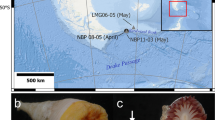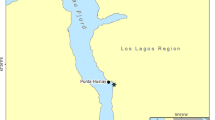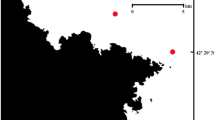Abstract
The reproductive ecology of colonies of Lophelia pertusa (Linné 1758) and Madrepora oculata Linné (1758) from the Porcupine Seabight (Thérèse Mound and South Porcupine Seabight site) and the Darwin Mounds (NE Rockall Trough—L. pertusa only) was investigated using histological techniques. Samples of L. pertusa exhibited seasonal reproduction, whereas the evidence for M. oculata is equivocal but suggests multiple cohorts of gamete production. L. pertusa produces a single cohort of around 3,000 oocytes, whereas M. oculata produces two cohorts, with a total fecundity of around 60 oocytes. The maximum observed oocyte size in L. pertusa was 140 μm and in M. oculata was 405 μm. From these oocyte sizes and the timing of reproduction, a lecithotrophic larva is expected, though not observed. This seasonality of reproduction fits with the phytodetrital food fall occurring around July in the Seabight area. L. pertusa was found to be non-reproductive at the Darwin Mound site. Though unable to be specifically tested, this may suggest that the increased trawling activity in this area might be keeping colonies below sexually viable sizes, as seen in numerous shallow water situations. All areas in the NE Atlantic are coming under threat from increased fishing and commercial exploration practices. This study shows that these highly seasonal reproducers could be sensitive to these fishing operations and care must be taken so as not to repeat the destruction that has occurred on shallower reefs.






Similar content being viewed by others
References
Bett BJ et al (1997) RRS Charles Darwin Cruise 101C Leg 2, 14 Jul-20 Aug 1996. Atlantic Margin Environmental Survey; seabed survey of the shelf edge and slope west of Shetland. Southampton Oceanography Centre, Southampton
Bett BJ (2001) UK Atlantic Margin Environmental Survey: introduction and overview of bathyal benthic ecology. Continental Shelf Res 21:8–10
Billett DSM, Lampitt RS, Rice AL, Mantoura RFC (1983) Seasonal sedimentation of phytoplankton to the deep-sea benthos. Nature 302:520–522
Brooke SD (2002) Reproductive ecology of a deep-water scleractinian coral, Oculina varicosa from the South East Florida Shelf. PhD Thesis, School of Ocean and Earth Science, Southampton Oceanography Centre, Southampton, 160pp
Brown BE (1987) Heavy metals pollution on coral reefs. In: Salvat B (ed) Impacts des activites humaines sur les recifs coralliens: connaissances et recommandations
Brown BE, Howard LS (1985) Assessing the effects of stress on reef corals. Adv Mar Biol 22:1–63
Cairns SD (1979 The deep-water Scleractinia of the Caribbean Sea and adjacent waters. Studies on the Fauna of Curacao and other Caribbean Islands, vol 57, 341 pp
Cairns SD (1982) Antarctic and Subantarctic scleractinia. Biol Antarctic Seas XI: Antarctic Res Ser 34:1–74
Cairns SD (1995) The marine fauna of New Zealand: Scleractinia (Cnidaria: Anthozoa). New Zealand Oceanography Institute Memoirs, vol 103, 210 pp
Dodge RE, Vaisnys JR (1977) Coral populations and growth patterns: responses to sedimentation and turbidity associated with dredging. J Mar Res 35:715–730
Fadlallah YH (1983) Sexual reproduction, development and larval biology in scleractinian corals: A review. Coral Reefs 2:129–150
Gage JD, Tyler PA (1991) Deep-sea biology: a natural history of organisms at the deep-sea floor. Cambridge University Press, Cambridge, p 504
Grigg RW (1974) Distribution and abundance of precious corals in Hawaii. Proceedings of the 2nd international symposium on coral reefs, vol 2
Grigg RW (1984) Resource management of precious corals: a review and application to shallow water reef building corals. Pubblicazioni della Stazione zoologica di Napoli I: Mar Ecol 5:57–74
Hall VR, Hughes TP (1996) Reproductive strategies of modular organisms: comparative studies of reef building corals. Ecology 77:950–963
Hall-Spencer J, Allain V, Fossa JH (2003) Trawling damage to North East Atlantic ancient coral reefs. Proc R Soc Lond 269(1490):507–511
Harrison PL, Wallace CC (1990) Reproduction, dispersal and recruitment of scleractinian corals. In: Dubinsky (ed) Ecosystems of the world: coral reefs. Elsevier, New York, pp 133–207
Keller NB (1993) New records of deep-sea madreporarian corals in the southern parts of the Atlantic and Indian oceans. In: Vinogradova NC (ed) Novye nakhodki glubokovodnykh madreporarij v yuzhnoj chasti Atlanticheskogo i Indijskogo okeanov, pp 89–96
Kojis BL, Quinn NJ (1982) Reproductive ecology of two faviid corals (Coelenterata: Scleractinia). Mar Ecol Prog Ser 8:251–255
Lampitt RS (1985) Evidence for the seasonal deposition of detritus to the deep-sea floor and its subsequent resuspension. Deep Sea Res 32:885–897
Lampitt RS, Bett BJ, Kiriakoulakis K, Popova EE, Ragueneau O, Vangriesheim A, Wolff GA (2001) Material supply to the abyssal seafloor in the Northeast Atlantic. Prog Oceanogr 50:1–4
LeGoff-Vitry M, Rogers AD, Baglow D (2004) A deep-sea slant on the molecular phylogeny of the Scleractinia. Mol Phylogenet Evol 30:167–177
Reed JK (1980) Distribution and structure of deep-water Oculina varicosa coral reefs off central eastern Florida. Bull Mar Sci 30:667–677
Richmond RH (1997) Reproduction and recruitment in corals: critcal links in the persistence of reefs. In: Birkeland C (ed) Life and death of coral reefs. Chapman and Hall, New York, pp 175–197
Rinkevich B, Loya Y (1989) Reproduction in regenerating colonies of the coral Stylophora pistillata. In: Luria M (ed) Environmental quality and ecosystem stability, pp 257–265
Rogers CS (1990) Responses of coral reefs and reef organisms to sedimentation. Mar Ecol Prog Ser 62:185–202
Rogers AD (1999) The biology of Lophelia pertusa (Linnaeus 1758) and other deep-water reef-forming corals and impacts from human activities. Int Rev Hydrobiol 84:315–406
Rogers CS, McLain L, Zullo E (1988) Damage to coral reefs in Virgin Islands National Park and Biosphere Reserve from recreational activities. In: Proceedings of the 6th international coral reef symposium, vol 2
Shilling FM, Manahan DT (1994) Energy metabolism and amino acid transport during early development of antarctic and temperate echinoderms. Biol Bull 187:398–407
Squires D (1965) Deep-water coral structure on the Campbell Plateau, New Zealand. Deep Sea Res 12:785–788
Szmant AM (1986) Reproductive ecology of Caribbean reef corals. Coral Reefs 5:43–54
Szmant-Froelich A (1985) The effect of colony size on the reproductive ability of the Caribbean coral Montastrea annularis (Ellis and Solander). In: Proceedings of the 5th international coral reef congress, vol 4, pp 295–300
Thiel H, Pfannkuche O, Schriever G, Lochte K, Gooday AJ, Hemleben C, Mantoura RFC, Turley CM, Patching JW, Riemann F (1989) Phytodetritus on the deep-sea floor in a central oceanic region of the Northeast Atlantic. Biol Oceanogr 6:203–239
Tyler PA, Harvey R, Giles LA, Gage JD (1992) Reproductive strategies and diet in deep-sea nuculanid protobranchs (Bivalvia: Nuculoidea) from the Rockall Trough. Mar Biol 114:571–580
Tyler PA, Gage JD, Paterson GJL, Rice AL (1993) Dietary constraints on reproductive periodicity in two sympatric deep-sea astropectinid seastars. Mar Biol 115:267–277
Vafidis D, Koukouras A, Voultsiadou-Koukoura E (1997) Actiniaria, Corallimorpharia, and Scleractinia (Hexacorallia, Anthozoa) of the Aegean Sea, with a checklist of the eastern Mediterranean and Black Sea species. Isr J Zool 43:55–70
Waller RG, Tyler PA, Gage JD (2002) The reproductive ecology of the deep-sea scleractinian coral Fungiacyathus marenzelleri (Vaughan, 1906) in the Northeast Atlantic Ocean. Coral Reefs 21:325–331
Waller RG, Tyler PA, Gage JD (2005) Sexual reproduction in three hermaphroditic deep-sea Caryophyllia species (Anthozoa:Scleractinia) from the NE Atlantic Ocean (in press)
Ward S (1995) The effect of damage on the growth, reproduction and storage of lipids in the scleractinian coral Pocillopora damicornis (Linnaeus). J Exp Mar Biol Ecol 187:193–206
Wheeler AJ, Bett BJ, Billet DSM, Masson D, Mayor D (2005) The impact of demersal trawling on the NE Atlantic deep-water coral habitats: the case of the Darwin Mounds, UK. In: Thomas J, Barnes P (eds) Benthic habitats and the effects of fishing, American Fisheries Society, Bethesda (in press)
Wilson JB (1979) The distribution of the coral Lophelia pertusa in the North East Atlantic. J Mar Biol Assoc UK 59:149–164
Wilson JB (1997) The deep-water coral Lophelia pertusa in the north-east Atlantic with particular reference to the west and north-west of Scotland and on the eastern margin of Rockall Bank. A report prepared for Greenpeace UK Ltd
Zibrowius H (1980) Les Scleractiniairies de la Mediterranee et de l’Atlantic nord-oriental. Mem Inst Oceanogr Monaco 11:247
Acknowledgments
This research was supported by the European Union ‘Atlantic Coral Ecosystem Study’ Contract No. EVK3-CT1999-00008. For sample collection we would like to thank Dave Billet, the Captains and crew of the RRS Discovery and Monty Priede for allowing us time and space on his cruises. We would also like to thank Bruce Hatcher and anonymous reviewers for useful comments and suggestions that greatly improved this manuscript.
Author information
Authors and Affiliations
Corresponding author
Rights and permissions
About this article
Cite this article
Waller, R.G., Tyler, P.A. The reproductive biology of two deep-water, reef-building scleractinians from the NE Atlantic Ocean. Coral Reefs 24, 514–522 (2005). https://doi.org/10.1007/s00338-005-0501-7
Received:
Accepted:
Published:
Issue Date:
DOI: https://doi.org/10.1007/s00338-005-0501-7




